Dash cams have become a popular tool for drivers to document their journeys and, inadvertently, any unexpected events on the road. For individuals involved in accidents, dash cam footage can serve as a crucial piece of evidence. In North Dakota, the admissibility of dash cam footage in court is a pertinent topic that can significantly impact the outcome of personal injury cases. This article explores the nuances of whether dash cam footage is admissible in North Dakota courts.
Is Dash Cam Footage Admissible in Court?
North Dakota operates under rules of evidence that govern what information can be presented in court. Admissibility is the legal term used to describe whether evidence is allowed in court proceedings. The primary goal is to ensure that the evidence presented is reliable, relevant, and fair to all parties involved.
For dash cam footage to be considered admissible in court, it must be both relevant and material to the case. Relevance means that the evidence has a logical connection to a fact in question, while materiality refers to the evidence’s importance in proving or disproving a particular issue. If the dash cam footage captures events related to the accident and is deemed essential to understanding the case, it may be considered admissible.
Proper authentication is crucial for any piece of evidence, including dash cam footage, to be admitted in court. This process involves verifying the legitimacy of the footage and ensuring that it has not been tampered with or altered. The individual presenting the dash cam footage must establish its authenticity, typically through a sworn affidavit or testimony from the person who recorded the footage.
There are also hearsay considerations to account for. Hearsay is an out of course statement offered to prove the truth of the matter asserted and is generally not admissible in court. Dash cam footage, however, is often considered a non-verbal, objective representation of events and may not be subject to hearsay objections. Still, it’s essential to present the footage in a way that avoids hearsay concerns and complies with the rules of evidence.
Privacy concerns may also come into play. North Dakota law generally allows the recording of public spaces, but recording private areas without consent may raise legal and ethical issues. Admissibility may be affected if the dash cam footage was obtained unlawfully or if it infringes on someone’s reasonable expectation of privacy.
Whether the dash can was in-car or external can also be relevant to admissibility. In addition to external dash cams mounted on the vehicle’s exterior, some cars come equipped with in-car cameras that record the interior of the vehicle. The admissibility of in-car camera footage may differ from that of external dash cams, and factors such as the purpose of the recording and the expectation of privacy within the vehicle may come into play.
Contact Pringle & Herigstad for a Consultation
Dash cam footage can be a valuable asset in personal injury cases, providing an objective record of events leading up to an accident. In North Dakota, the admissibility of dash cam footage depends on various factors, including relevance, authentication, and privacy considerations. At Pringle & Herigstad we can help you navigate the legal complexities, assess the admissibility of the evidence, and work to ensure a fair presentation of your case in court. Contact us today.
